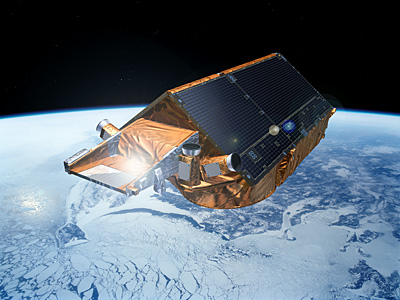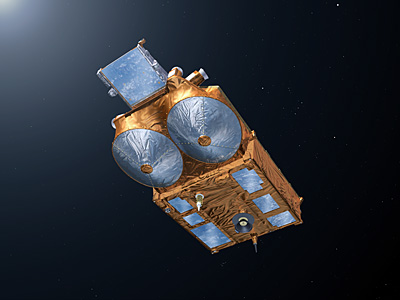Launch site:
Baikonur Launch silo no. 109/95 45°57'4.21"N, 63°29'49.36"E
Launch date:
April 8, 2010
The launch time is:
19:57:04 Baikonur 08.04.2010
17:57:04 Moscow Local 08.04.2010
13:57:04 UTC Apr 8, 2010
9:57:04 a.m. EDT Apr 8, 2010
[eventTimer]2010-04-08 13:57:04?before|after;%dd% Days %hh% Hours %mm% Minutes %ss% Seconds %c%[/eventTimer]CryoSat II Launch
Payload:
CryoSat II Earth observation satellite
Launch Mass:
720 kg
Target orbit:
Low-Earth, non-Sun-synchronous; 717 km
Orbital Period:
100 minutes
Nominal Mission:
3.5 years
CryoSat mission history
CryoSat was an ESA satellite that was destroyed on launch October 8, 2005 when the second stage engine of a modified Russian SS-19 ICBM did not cut-off as planned.[1][2] CryoSat was proposed in 1998 by Duncan Wingham of University College London. The satellite's planned three year mission was to survey natural and human driven changes in the cryosphere on Earth. It was designed to provide much more accurate data on the rate of change of the surface elevation of the polar ice sheets and sea ice thickness. It was the first ESA Earth Sciences satellite selected through open, scientific competition.
CryoSat was launched from the Plesetsk Cosmodrome in Russia, using a Rockot launcher. (Rockot is a modified SS-19 rocket which was originally an ICBM designed to deliver nuclear weapons, but which Russia is now eliminating in accordance with the START treaties.) According to Mr. Yuri Bakhvalov, First Deputy Director General of the Khrunichev Space Centre, when the automatic command to switch off the second stage engine did not take effect, the second stage continued to operate until it ran out of fuel and as a consequence the planned separation of the third (Breeze-KM) stage of the rocket which carried the CryoSat satellite did not take place, and would thus have remained attached to the second stage. The upper rocket stages, together with the satellite, probably crashed in the Lincoln Sea.
Analysis of the error revealed that it was caused by faults in the programming of the rocket, which had not been detected in simulations.
After the launch failure of CryoSat, ESA immediately started to plan a replacement CryoSat mission. This included securing the industrial team which had built the original, ordering parts which have a long delivery time and establishing a funding scheme within existing budgets. Due to the importance of the scientific goals of this satellite, there was enormous support for this, and the initial phases for CryoSat-2 were approved when ESA's Earth Observation Programme Board agreed to build a copy of the spacecraft on February 23, 2006.
Spacecraft:
CryoSat II
CryoSat-2's primary payload is the SAR/Interferometric Radar Altimeter (SIRAL), which has extended capabilities to meet the measurement requirements for ice-sheet elevation and sea-ice freeboard.
CryoSat-2 will also carry three star trackers for measuring the orientation of the baseline. In addition, a radio receiver called Doppler Orbit and Radio Positioning Integration by Satellite (DORIS) and a small laser retroreflector ensures that CryoSat-2's position will be accurately tracked.
Unlike most satellites, CryoSat does not have any deployable solar panels; in fact the satellite has no moving parts at all, except for some valves in the propulsion system.
This has enabled a very significant cost saving, but does pose some problems for the provision of adequate solar power in Cryostat-2's unusual orbit. The solar panels are rigidly fixed to the satellite body, forming a "roof" with a carefully optimised angle, which provides adequate power under all orbital conditions and still fits within the launch vehicle.
Manufacturer:
EADS Astrium
Launcher:
Dnepr
Parameter|Value
Weight at liftoff|211 tons
Propellant|amyl + heptyl
Number of stages|3
LV diameter|3 meters
LV length|34 meters
Injection accuracy:|
o For orbit altitude|+/- 4,0 km
o For orbit inclination|+/- 0.04 degrees
o For right ascension of the ascending node|+/- 0.05 degrees
Orbit inclinations|64.5; 98.0 degrees
Flight reliability|0.97
Operational environments:|
o Longitudinal g-load|up to 7.5
o Lateral g-load|up to 0.8
Integral level of sound pressure|up to 140 dB
Launch type|steam ejection from Transport and Launch Canister (TLC)
A typical mission Profile
Described here:
http://www.kosmotras.ru/en/shema_polet/
Manufacturer:
Yuzhnoe Design Bureau in Dnepropetrovsk, Ukraine
The vehicle's
reliability statistics according to
http://www.spacelaunchreport.com/reliability2010.txt:
Launch Timeline
http://s002.radikal.ru/i199/1004/b7/24f60d1634d7.jpg[/B]
[code]
================================================================
Vehicle Successes/Tries Realzd Pred Consc. Last Dates
Rate Rate* Succes Fail
================================================================
Dnepr 12 13 .92 .87 6 7/26/06 1999-
[/code]
[B]Weather forecast for Baikonur, Kazakhstan on April 8, 2010[/B]
[IMG]http://deskwx.weatherbug.com/images/Forecast/icons/cond003.gif
Hi: 12°C
Lo: 2°C
There is a 0% chance of precipitation. Partly cloudy. Mild. Temperature of 12°C. Winds E 21km. Humidity will be 51% with a dewpoint of 2° and feels-like temperature of 12°C.
Sunrise/Sunset and associated twilight times for Baikonur on Saturday, April 8, 2010
Times are local.
Event|Time
Astronomical twilight begins|05 : 26
Nautical twilight begins|06 : 05
Civil twilight begins|07 : 42
Sunrise|07 : 11
Transit (sun is at its highest)|13 : 25
Sunset|20 : 25
Civil twilight ends|20 : 54
Nautical twilight ends|21 : 31
Astronomical twilight ends|22 : 10
Watching the launch live
Watch for updates in
CryoSat II Launch Blog:
http://cslariviere.blogspot.com/
I won't be watching over this launch, because I'm embarking on a trip. Have a good watching, folks!
Notebook: would you make the topic name more generic?








